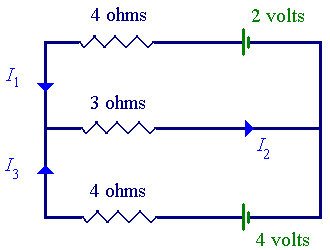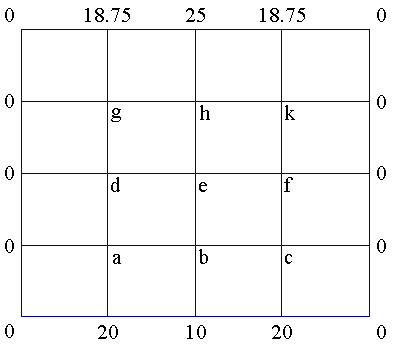S = { (x, y) |
(-1, 5), (0, 2), (2, -8) }
The required determinant is
| x0 | x1 |
x2 | y |
| 1 | -1 |
(-1)2 | 5 |
| 1 | 0 |
02 | 2 |
| 1 | 2 |
22 | -8 |
The presence of the zeroes in row 3 suggests a cofactor expansion.
In order to make the collection of coefficients easier, expand
initially along row 1:
| x^0 x^1 x^2 y | | -1 1 5 | | 1 1 5 |
| 1 -1 1 5 | = | 0 0 2 | - | 1 0 2 | x
| 1 0 0 2 | | 2 4 -8 | | 1 4 -8 |
| 1 2 4 -8 |
| 1 -1 5 | 2 | 1 -1 1 |
+ | 1 0 2 | x - | 1 0 0 | y = 0
| 1 2 -8 | | 1 2 4 |
The coefficient of x0, by cofactor expansion
along row 2, is
| -1 1 5 |
+ | 0 0 2 | = - 0 + 0 - 2 | -1 1 |
| 2 4 -8 | | 2 4 |
= -2 * (-4 - 2) = +12
The coefficient of x1, by cofactor expansion
along row 2, is
| 1 1 5 |
- | 1 0 2 | = -( -1 | 1 5 | + 0 - 2 | 1 1 | )
| 1 4 -8 | ( | 4 -8 | | 1 4 | )
= +1 * (-8 - 20) + 2 * (4 - 1) = -28 + 6 = -22
The coefficient of x2, by cofactor expansion
along row 2, is
| 1 -1 5 |
+ | 1 0 2 | = -1 | -1 5 | + 0 - 2 | 1 -1 |
| 1 2 -8 | | 2 -8 | | 1 2 |
= -1 * (8 - 10) - 2 * (2 + 1) = 2 - 6 = -4
The coefficient of y, by cofactor expansion
along row 2, is
| 1 -1 1 |
- | 1 0 0 | = - ( -1 | -1 1 | + 0 - 0 )
| 1 2 4 | ( | 2 4 | )
= +1 * (-4 - 2) = -6
The required polynomial is therefore
12 - 22 x
- 4 x2
- 6 y = 0
Þ
6 - 11 x
- 2 x2
- 3 y = 0
Þ
|
y = (-2 x2
- 11 x + 6) / 3
|
As a check, substitute each point in turn into this
equation to show that this parabola does pass through all three
points:
6 - 11 x
- 2 x2
- 3 y = 0 :
6 - 11×(-1)
- 2×(-1)2
- 3×(5)
= 6 + 11 - 2 - 15 = 0.
Ö
6 - 11×(0)
- 2×(0)2
- 3×(2)
= 6 + 0 + 0 - 6 = 0.
Ö
6 - 11×(2)
- 2×(2)2
- 3×(-8)
= 6 - 22 - 8 + 24 = 0.
Ö
S = { (x, y) |
(-2, 8), (-1, 3),
(1, -5), (2, 9) }
The required determinant is
| x0 | x1 |
x2 | x3 |
y |
| 1 | -2 |
(-2)2 |
(-2)3 |
8 |
| 1 | -1 |
(-1)2 |
(-1)3 |
3 |
| 1 | 1 |
12 |
13 |
-5 |
| 1 | 2 |
22 |
23 |
9 |
There are no zero entries in this 5×5 determinant.
Therefore carry out a partial row reduction to introduce some
zero entries:
R3 ¬
R3 - R2,
R4 ¬
R4 - R2,
R5 ¬
R5 - R2:
| x0 | x1 |
x2 | x3 |
y |
| 1 | -2 |
4 |
-8 |
8 |
| 0 | 1 |
-3 |
7 |
-5 |
| 0 | 3 |
-3 |
9 |
-13 |
| 0 | 4 |
0 |
16 |
1 |
R2 ¬
R2 + 2 R3,
R4 ¬
R4 - 3 R3,
R5 ¬
R5 - 4 R3:
| x0 | x1 |
x2 | x3 |
y |
| 1 | 0 |
-2 |
6 |
-2 |
| 0 | 1 |
-3 |
7 |
-5 |
| 0 | 0 |
6 |
-12 |
2 |
| 0 | 0 |
12 |
-12 |
21 |
| = 2 × 3 × |
| x0 | x1 |
x2 | x3 |
y |
| 1 | 0 |
-2 |
6 |
-2 |
| 0 | 1 |
-3 |
7 |
-5 |
| 0 | 0 |
3 |
-6 |
1 |
| 0 | 0 |
4 |
-4 |
7 |
|
We could continue with the row reduction, but the cofactor
expansion is now easier than it would have been earlier.
Row reduction much beyond this point will result in the introduction
of non-integer entries.
[The reduced echelon form of rows 2 to 5 is
| x0 | x1 |
x2 | x3 |
y |
| 1 | 0 |
0 |
0 |
-25/6 |
| 0 | 1 |
0 |
0 |
-65/12 |
| 0 | 0 |
1 |
0 |
19/6 |
| 0 | 0 |
0 |
1 |
17/12 |
, from which
([50
+ 65 x
- 38 x2
- 17 x3] / 12)
+ y = 0. ]
In order to make the collection of coefficients easier, expand
initially along row 1:
| x^0 x^1 x^2 x^3 y |
| 1 0 -2 6 -2 |
| 0 1 -3 7 -5 | = 0 =
| 0 0 3 -6 1 |
| 0 0 4 -4 7 |
| 0 -2 6 -2 | | 1 -2 6 -2 | 1
| 1 -3 7 -5 | - | 0 -3 7 -5 | x
| 0 3 -6 1 | | 0 3 -6 1 |
| 0 4 -4 7 | | 0 4 -4 7 |
| 1 0 6 -2 | 2 | 1 0 -2 -2 | 3
+ | 0 1 7 -5 | x - | 0 1 -3 -5 | x
| 0 0 -6 1 | | 0 0 3 1 |
| 0 0 -4 7 | | 0 0 4 7 |
| 1 0 -2 6 |
- | 0 1 -3 7 | y = 0
| 0 0 3 -6 |
| 0 0 4 -4 |
The coefficient of x0, by cofactor expansion
down column 1, is
| 0 -2 6 -2 | | -2 6 -2 |
+ | 1 -3 7 -5 | = 0 - 1 | 3 -6 1 | + 0 - 0
| 0 3 -6 1 | | 4 -4 7 |
| 0 4 -4 7 |
= -( -2 | -6 1 | - 3 | 6 -2 | + 4 | 6 -2 | )
( | -4 7 | | -4 7 | | -6 1 | )
= -( -2*(-42 + 4) - 3*(42 - 8) + 4*(6 - 12) )
= -( 76 - 102 - 24) = +50
The coefficient of x1, by cofactor expansion
down column 1, is
| 1 -2 6 -2 | | -3 7 -5 |
- | 0 -3 7 -5 | = 1 | 3 -6 1 | - 0 + 0 - 0
| 0 3 -6 1 | | 4 -4 7 |
| 0 4 -4 7 |
= -( -3 | -6 1 | - 3 | 7 -5 | + 4 | 7 -5 | )
( | -4 7 | | -4 7 | | -6 1 | )
= -( -3*(-42 + 4) - 3*(49 - 20) + 4*(7 - 30) )
= -( 114 - 87 - 92 ) = +65
The coefficient of x2, by cofactor expansion
down column 1 (then column 1 of the 3×3 determinant), is
| 1 0 6 -2 | | 1 7 -5 |
+ | 0 1 7 -5 | = 1 | 0 -6 1 | = 1 | -6 1 |
| 0 0 -6 1 | | 0 -4 7 | | -4 7 |
| 0 0 -4 7 |
= 1(-42 + 4) = -38
The coefficient of x3, by cofactor expansion
down column 1 (then column 1 of the 3×3 determinant), is
| 1 0 -2 -2 | | 1 -3 -5 |
- | 0 1 -3 -5 | = -1 | 0 3 1 | = -1 | 3 1 |
| 0 0 3 1 | | 0 4 7 | | 4 7 |
| 0 0 4 7 |
= -1(21 - 4) = -17
The coefficient of y, by cofactor expansion
down column 1 (then column 1 of the 3×3 determinant), is
| 1 0 -2 6 | | 1 -3 7 |
+ | 0 1 -3 7 | = 1 | 0 3 -6 | = 1 | 3 -6 |
| 0 0 3 -6 | | 0 4 -4 | | 4 -4 |
| 0 0 4 -4 |
= 1(-12 + 24) = +12
The required polynomial is therefore
50 + 65 x
- 38 x2
- 17 x3
+ 12 y = 0
Þ
|
y = (17 x3
+ 38 x2
- 65 x - 50) / 12
|
As a check, substitute each point in turn into this
equation to show that this curve does pass through all four
points:
50 + 65 x
- 38 x2
- 17 x3
+ 12 y = 0:
50 + 65(-2)
- 38(-2)2
- 17(-2)3
+ 12(8)
= 50 - 130 - 152
+ 136 + 96 = 0.
Ö
50 + 65(-1)
- 38(-1)2
- 17(-1)3
+ 12(3)
= 50 - 65 - 38
+17 +36 = 0.
Ö
50 + 65(1)
- 38(1)2
- 17(1)3
+ 12(-5)
= 50 + 65 - 38 - 17
- 60 = 0.
Ö
50 + 65(2)
- 38(2)2
- 17(2)3
+ 12(9)
= 50 + 130 - 152 - 136
+ 108 = 0.
Ö

